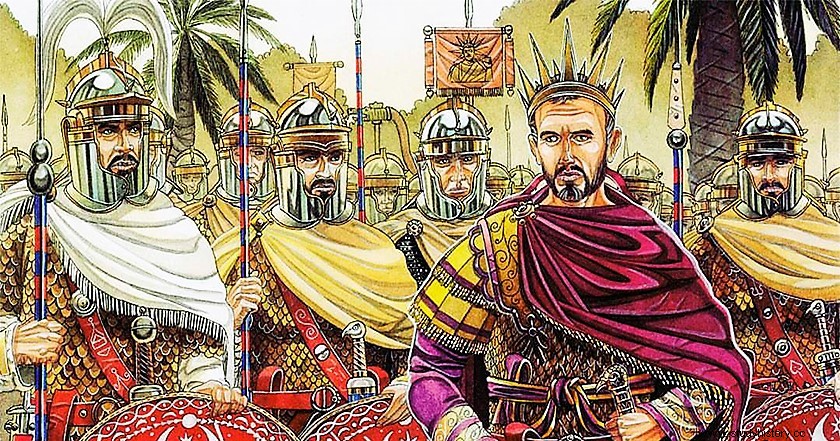
After the death of Alexander Severus, the last emperor of the Severan Dynasty in the year 235, we are witnessing the most terrible years in the history of Rome. Known as the Crisis of the Third Century, they were about to end the greatest power that the Mediterranean had ever known.
Endless usurpations, disorders and invasions of the imperial limes by barbarian peoples, emancipations and births of new empires within the same Empire. All this seasoned with natural catastrophes, famines or terrible plague epidemics. The imperial economy was almost completely paralyzed, industry, agriculture, and especially Mediterranean trade left the imperial coffers at their lowest levels in the history of the Roman Empire.
All these aspects are continually reviewed by current historiography. There are many who venture to say that, in some of the provinces such as Britania, or Hispania to a lesser extent, the effects of the crisis were not so profound. But one fact stands out above all, the almost total absence of primary sources leads us to think of the climate of total chaos of the previous imperial structures.
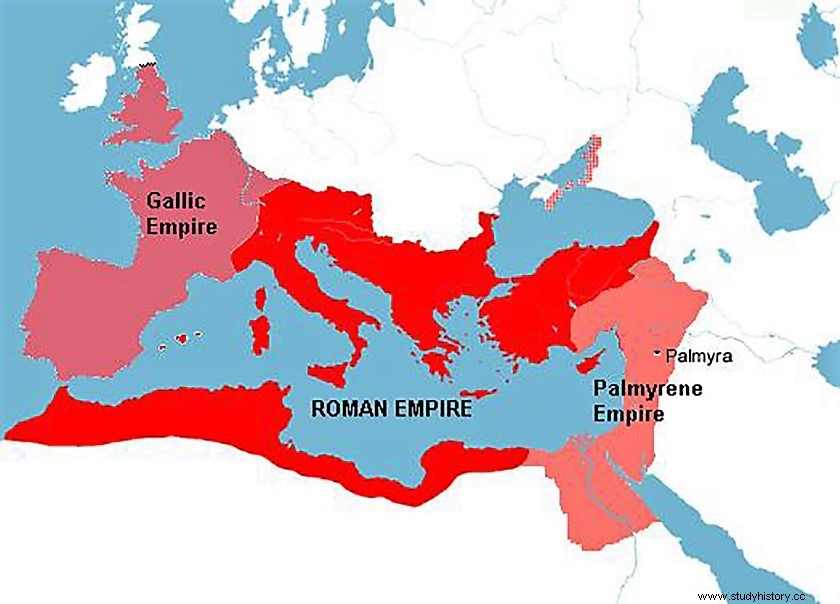
The Empire during the crisis of the third century
Well, contemporary historiography has placed two emperors in positions of honor as saviors of the imperial catastrophe:on the one hand, Diocletian (284-305) and on the other the great Constantine (306-337). Sometimes overlooking our protagonist today, Aurelian (270-275), who in just five years laid the foundations for the imperial recovery, serving as a precedent for the best times the empire experienced in the fourth century.
Aurelian's rise to power.
Little to almost nothing is known about the origins of Lucius Domitius Aurelianus. Not even the sources agree on his birthplace, somewhere in Dacia, possibly in Sirmium. Son of a character who seems to have held a low-ranking military position, but with great affinity with the Roman senator Aurelio.
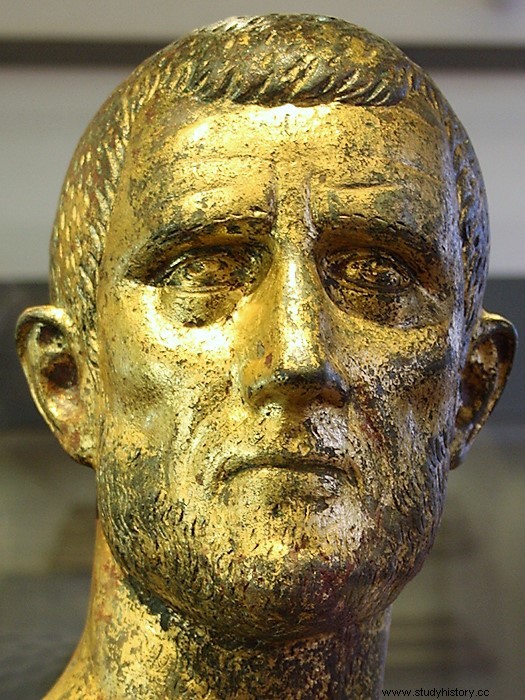
Aureliano
Aurelian's rise in the ranks of the Roman army culminated in the time of Emperor Galliano (253-268) and especially with his successor Claudius II (268-270). After the death of the latter, the legions of Sirmium elevated Aurelian to emperor, against the senatorial decision to elect Quintillus. As was customary at the time, Aurelian's troops headed for Rome to take over the imperial title. The sources are not very clear, but it seems that Quintilo, faced with the minimal possibilities of his small army, took his own life. In such a way that Aurelian became the third emperor of the Illyrian Dynasty.
Aurelian, a military emperor.
As has been pointed out, when Aurelian came to power in the late summer of 270, the Roman Empire was in complete chaos. Two emancipated powers; the Gallic Empire and the Empire of Palmyra, and as if that were not enough, the Germanic peoples roaming freely in the vicinity of the imperial capital, with the deserted Alps turned into a real drain.
His first job leading the legions of Rome as emperor was to cleanse Alamanni and Marcomanni the Empire. After expelling them, Aureliano agreed with the Gothic people to protect the northern border, while at the same time reinforcing Dacia, establishing two new heavily militarized provinces, Dacia Ripuaria and Mediterranean Dacia. To complete the protection he was set in the capital itself; Rome had to be better protected against the supposed Germanic advances, hence the need to build the Aurelian walls , which would protect Rome for the rest of the Late Empire.
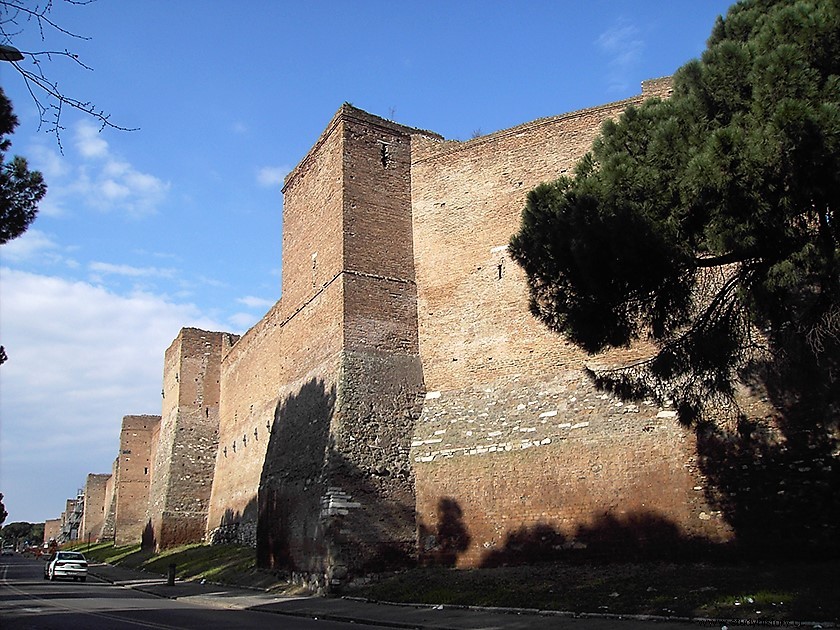
Aurelian Walls
His next destination was to finish off the insurgent queen of Palmyra, Julia Aurelia Zenobia . Since the death of her husband, Odenato she, this she was placed at the head of the Empire of Palmyra as regent of Vabalato, the son of both, only one year old. It was clear with the political movements of Zenobia, the intention to perpetuate the emancipation of Rome, to turn the eastern part of the Roman Empire into a hereditary monarchy in the likeness of the Persian kings. It was not in vain that the city of Palmyra was the richest in the East, thanks to its control of the caravan routes.
Between the years 270-271 and taking advantage of Aurelian's problems with the Germanic peoples, Zenobia had incorporated new territories into her Empire, including Egypt and much of Asia Minor . All this thanks to the generals of Palmyra, who Zenobia had placed at the head of the eastern legions.
In the year 272 Aureliano sets course for the East. The first victories in Asia Minor continued with the defeats of the Palmyrene cataphracts in the vicinity of Antioch or Emesa. After them the siege of the capital, Palmyra, during which the queen flees, but she is taken prisoner and later sent to Rome. A new insurrection in 273 forced a new intervention of the Roman army, it was the greatest defeat of Palmyra, the city that will begin a prolonged decline after the loss of the caravan routes.
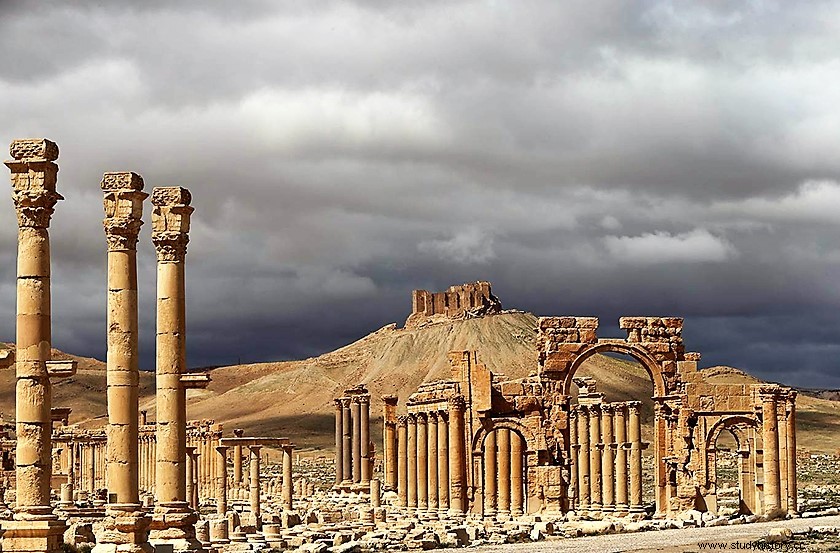
Palmyra
The one known as the Gallic Empire It was Aureliano's next job. Posthumously a general based in Gaul, he had proclaimed himself Western Emperor. Under his control, from the year 260 approximately, other provinces such as Britannia or Hispania were apart from Gaul for some years. For sure, it is intuited that, upon the arrival of Aureliano, only Gaul continued to act as emancipated, since, after the death of Postumus, a year before the arrival of our protagonist to power, both Britannia and Hispania appeared in the orbit of Rome.
The restoration of power was not very complicated, the enormous crisis had also caused a dent in Gaul. After the death of Postumus, several characters became Western emperors, but none of them with the perseverance of the first. To show the last of them, Tetricus, who in the year 274 supposedly handed over the Gallic Empire to Aurelian. Other sources speak of the Roman emperor defeating the Gaul on the battlefield, but there is no evidence. A few months later Tetricus appears as governor of a region in southern Italy, synonymous with some kind of pact between him and the Roman emperor.
Aurelian's economic reforms.
Military work was not the only field where Aureliano stood out. The economic disaster of the Empire necessitated swift action. Aurelian tried it by applying old economic policies from the good old days of Rome. One of his first decisions was to force the peasants to till the wastelands, imposing taxes on the lands adjoining their possessions, in order to mitigate the famine of the Empire. With the new products he launched the old charitable services, distributing basic food among the most humble population. In addition, he acted on taxation, especially in the insurgent territories, with tax increases among the highest layers of society.
The recovery of metals from the provinces of Hispania, Britannia and the treasure seized after the conquest of Palmyra, was used by Aureliano to launch a monetary reform. The minting of coins was massive, both gold, silver or bronze. It is clear that the emperor tried to act quickly on the problem, but the consequences of this haste were evident in later years. He did not count on the Roman Senate, which continually opposed monetary reforms, fearful of losing the monopoly on minting bronze coins. Nor did he take into account the inflationary problem that had plagued the Empire in previous years, which is why the coins put into circulation by Aureliano soon fell in value.
Despite the errors, he returned monetary circulation to the Empire, so that Aurelian's risky measures laid the foundations for economic recovery at the end of the third century and the beginning of the IV.
Aurelian's religious changes in the Empire.
The classic religious polytheism of the Empire had not stopped growing during the years in which Rome was conquering territories. In short, the religious permissiveness of the Empire caused the pantheon of Roman Gods to grow disproportionately, due to the assimilation of divinities from the different cultures that made up the Empire in the 3rd century.
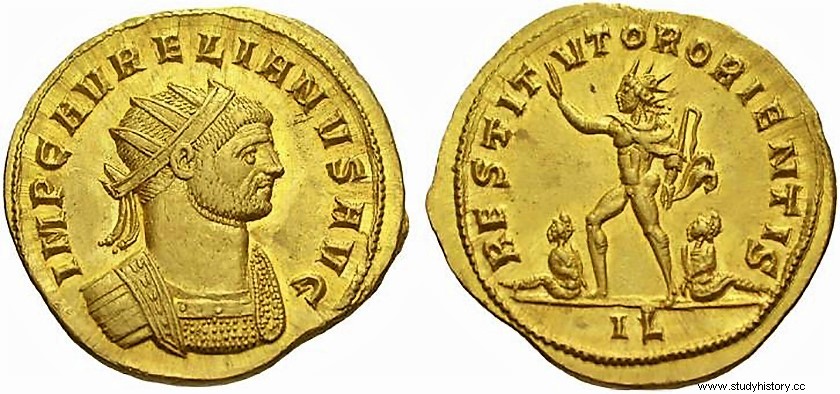
Gold aureus with the representation of Aureliano and the Sol Invictus.
As soon as Aureliano came to power, he was aware that in order to control the Empire he needed a religious figure who would become an official, without canceling the others he should unite as much as possible to the peoples of the Empire. The chosen divinity was the “Sol Invictus ”, which could reconcile Mithraic cults, majority among the legions, as well as Pannonians or the Solar God of Emesa. Philosophically, the prevailing Neoplatonism facilitated the arrival of the new cult in the Empire.
Aureliano had his new coins made with the Sun God, in addition to building a new temple on the Champ de Mars dedicated to the new main deity of the Empire. Most of the social, cultural and religious classes accepted the new official religion of the Empire, with the clear exception of the Christian societies that refused to accept it. Undoubtedly, the great persecution by Diocletian in the year 303 had its origins in this refusal, since the "Sol Invictus" remained the official religion of the Empire until the definitive consecration of Christianity.
The great political, military, economic and religious work of Aurelian did not end with a stroke of the pen with the great crisis of the third century, but without a doubt he laid the foundations that the successors knew how to take advantage of. of the; especially Diocletian and Constantine to lengthen the history of the Western Roman Empire for almost two more centuries. Although this work raised the obvious misgivings among those closest to him, who murdered them on the way to Persia, only five years had passed since he came out with the purple of Rome.
The Fall of the Roman Empire, Adrian Goldswhorty, Ed. The Sphere of Books, 2009
Ancient History II, history of Rome, Pilar Fernadez and Javier Cabrero, Ed. Uned, 2014
